Table of contents
- Tuning Ducati 1299 Panigale correctly Driver assistance systems and chassis
- SECTION
- Video of the Nordschleife crossover test
- Ducati Traction Control (“DTC”)
- Ducati Wheelie Control (“DWC”)
- Power delivery (“Engine”)
- Semi-active chassis (“OF”) 1299 Panigale S.
- Ducati Quickshifter (“DQS”)
- Engine braking control (“EBC”)
- “default”
- Setup (dry conditions)
- interview
- Accessories on the Ducati 1299 Panigale / S
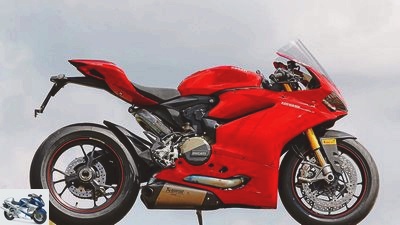
markus-jahn.com
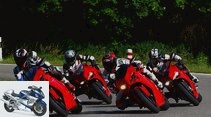
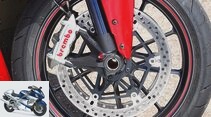
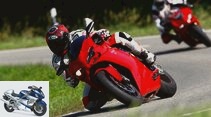
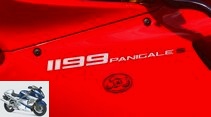
28 pictures
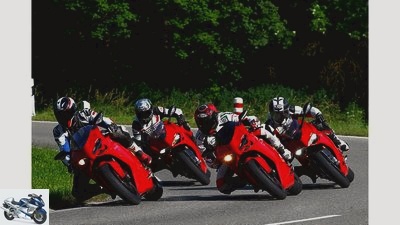
fact
1/28
Ducati Superbikes in a generation comparison.
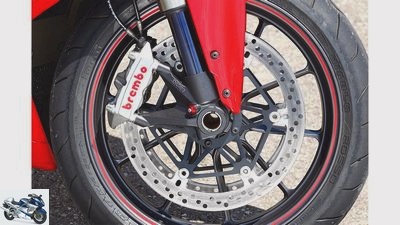
fact
2/28
Bite-proof and easy to dose: anchor of the 1198. ABS was not available in either her or the 1098.

fact
3/28
The 1198s in action.
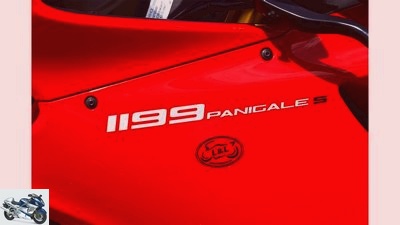
fact
4/28
Ducati 1199 Panigale S..
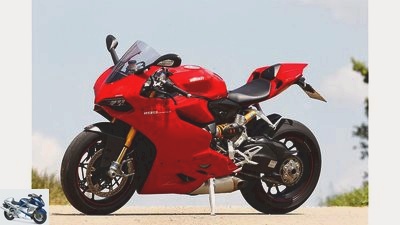
fact
5/28
It sets a best time when accelerating from 0 to 150: 4.9 seconds.
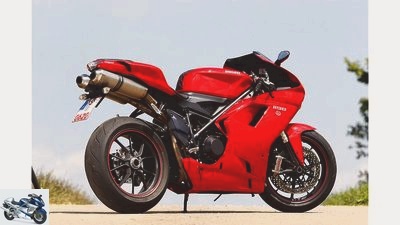
fact
6/28
Since the displacement remained the same compared to the 1198, its name is again slightly misleading.
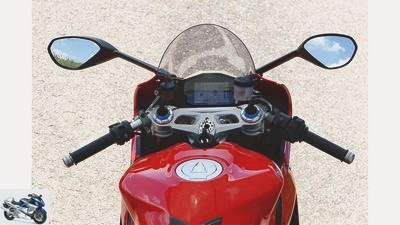
fact
7/28
The sweeping bubble screen comes from the accessories and offers good wind protection. The high-contrast TFT cockpit (TFT = Thin Film Transistor) was used for the first time in the 1199.
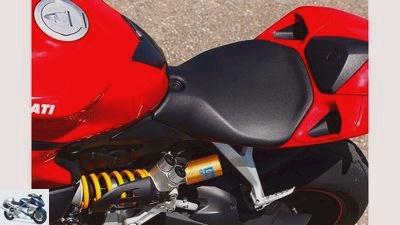
fact
8/28
The slippery bench hardly offers any support. New: strut attached to the side.
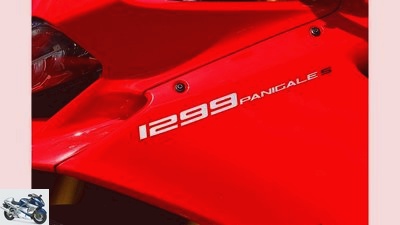
fact
9/28
Ducati 1299 Panigale S..
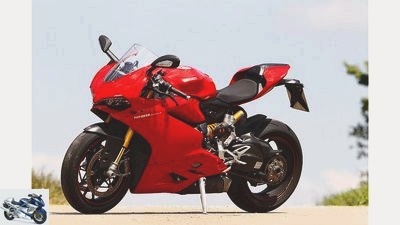
fact
10/28
Thanks to a further increase in displacement, the 1299 brings it to 1285 cm³, which it distributes between its two cylinders.
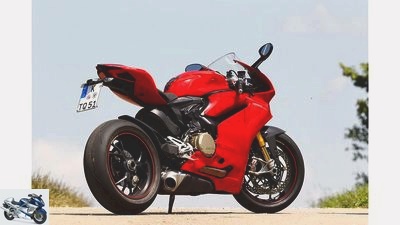
fact
11/28
In terms of acceleration 0-200 km / h (7.5 s) and top speed (299 km / h) and pulling power (50-100 km / h: 4.3 s; 100-150 km / h: 3.8 s) don’t fool her.
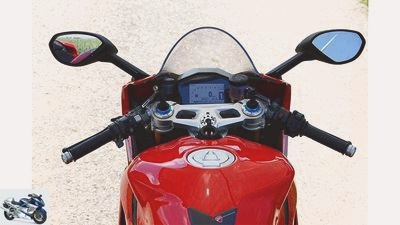
fact
12/28
Thanks to expanded electronics, the 1299 cockpit offers a little more setting options than that of the 1199.
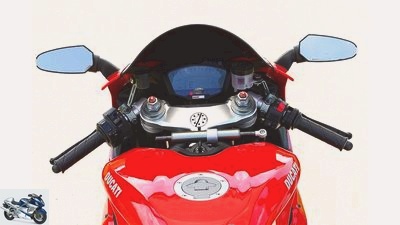
fact
13/28
Like the entire workstation, the 1198 also took over most of the other add-on parts from the 1098. The standard version can be recognized by the Showa spring elements.
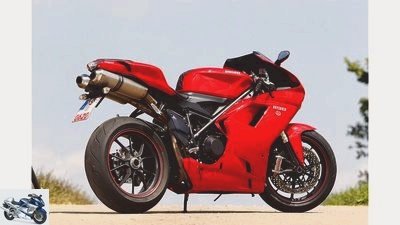
fact
14/28
With a nominal 170 hp, it is eight hp higher than the Ducati 1098, but the successors are missing 25 hp (1199 Panigale S) or 35 hp (1299 Panigale S).
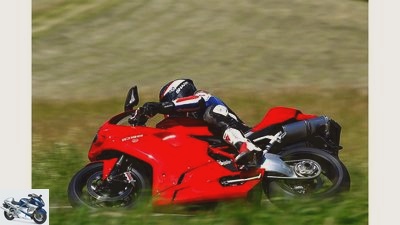
fact
15/28
Ducati 1098.

fact
16/28
Ducati 1198.
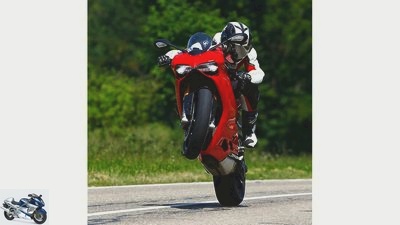
fact
17/28
Ducati 1199 Panigale S..
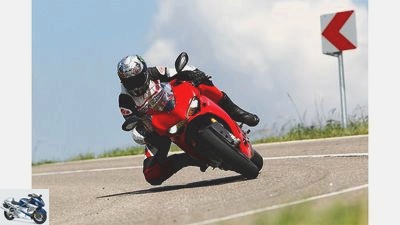
fact
18/28
And Ducati 1299 Panigale S..
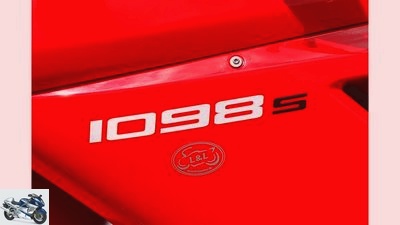
fact
19/28
Ducati 1098.
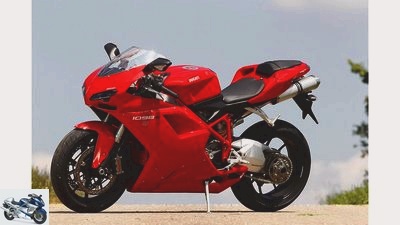
fact
20/28
1098 has 1099 cm³, even if its name suggests otherwise.
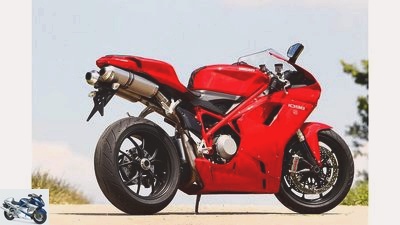
fact
21/28
In terms of acceleration from 0 to 100 km / h, it is 3.1 seconds ahead of the other three.
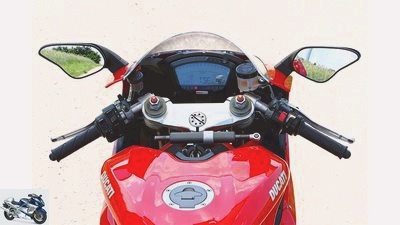
fact
22/28
While its predecessor, the 999 / S, still had analog round instruments, the digital dashboard was used for the first time in the 1098. The readability is mediocre.
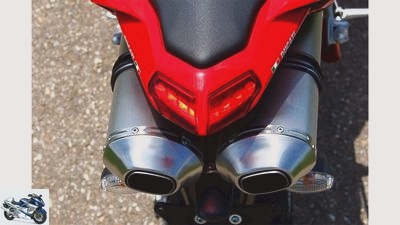
fact
23/28
The people cheered in 2007: finally an under-seat system with two mufflers again.
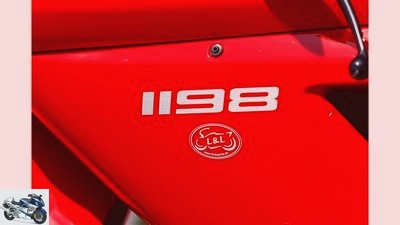
fact
24/28
Ducati 1198.
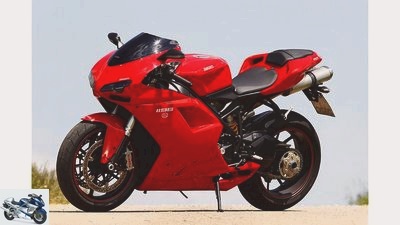
fact
25/28
Thanks to an increase in cubic capacity compared to the previous model, the model name and cubic capacity now match: 1198 cm³.
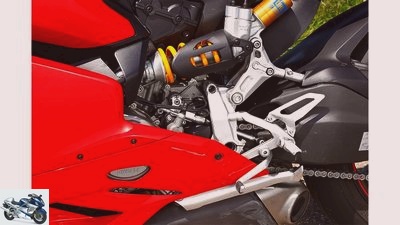
fact
26/28
The S model now has a semi-active chassis. The automatic gearshift has been expanded to include the blipper function (clutch-free downshifting).
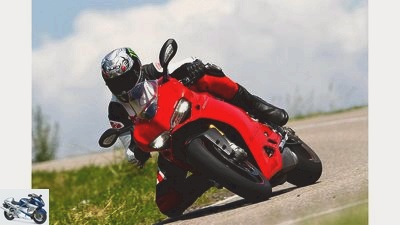
fact
27/28
The Ducati 1299 Panigale S in action.

fact
28/28
Ducati Superbikes in a generation comparison.
counselor
workshop
Ducati 1299 Panigale assistance systems coordinate setup
Tuning Ducati 1299 Panigale correctly
Driver assistance systems and chassis
Content of
The electronic assistance systems in modern sports motorcycles support the driver, but make perfect coordination difficult. That is why we are going into more detail about the driver assistance on high-tech bikes.
Volkmar Jacob
09/14/2016
Hand on heart: you have with yours Ducati 1299 Panigale / S Have you ever tried out all the settings of the driver assistance systems? Yes? And did you come up with an ideal setup? Congratulations! Then you don’t need to read any further. If not, you might be interested in the start of our new series. This is where we feel ABS, traction control & Co., modern athletes, both on the racetrack and on the country road, scrutinize the digital tooth and reveal which settings you should choose – and which better not.
Buy complete article
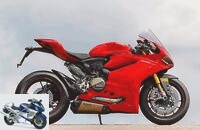
Tuning Ducati 1299 Panigale correctly
Driver assistance systems and chassis
6 pages) as PDF
€ 2.00
Buy now
Most of the assistance systems in the Ducati 1299 Panigale / S are based on the “Inertial Measurement Unit” (IMU). It uses special sensors to continuously check the riding condition of the bike and sends this data to various receivers in the on-board electronics. This intervenes as required and prevents, for example, locking, lifting or breaking wheels. In the three driving modes “Race”, “Sport” and “Wet”, Ducati has already preset the assistance and determined very decent setups on and off the racetrack. Nevertheless, our voting deviates significantly from the factory recommendations in some cases.
SECTION
With levels one to three and an additional “Off” function, the Ducati 1299 Panigale / S offers a wide range of anti-lock protection options. The sharpest position (one) regulates very late, deactivating both the lift-off detection on the rear wheel and its ABS. As a result, the Panigale enables braking drifts, which, however, are difficult to conjure up on the parquet due to their superb braking stability. In any case, the disabled lift-off detection is more important. The ABS does not regulate even if the rear wheel loses contact with the ground. In extreme cases, this can lead to a forward somersault, but it allows ultra-short braking distances. Tip: To avoid the rollover, first apply the brake gently and then increase the pressure. Ideally, brake slightly at the rear. If at all, the rear wheel then only climbs slowly and controllably.
Our favorite ABS setting, however, is level two. The lift detection is also inactive here and the system intervenes just as late as it did in position one. Even fast laps on the racetrack didn’t make it work during our test. The difference: Level two activates both the anti-lock protection on the rear wheel and the lean angle-dependent ABS of the Ducati 1299 Panigale / S, colloquially called cornering ABS. Sensible conditions (warm tires, dry and clean track) allow the pilot to pull the lever fully without flying off, even in a great lean angle. Reason: The electronics control the brake pressure depending on the lean angle and only allow enough braking force to prevent the wheels from locking at any time. Basically a great thing! Only the increasing deceleration with decreasing lean angle and sustained high pull on the lever causes the rear of the Duc to rise from time to time and moves it inward while cornering. This instability takes getting used to and requires an attentive pilot.
Video of the Nordschleife crossover test
On the slopes, however, it is important to brake smoothly from anchoring straight into the curves. And the Ducati 1299 Panigale / S does this exercise with flying colors. In the beginning, the pen goes well and everything in one is reluctant to stay fully in the iron in an inclined position. But once you have overcome this and felt how reliably the system works, these maneuvers are increasingly easier and pave the way for late braking attacks. The cornering ABS shows us hobby racers what strong delays are possible in an inclined position and where we can still work on the lap times. What is astonishing is that the Ducati system supposedly does not even come close to exhausting the physical limit. The rumor mill reports that relevant manufacturers are currently working intensively on this limit and are developing appropriate algorithms. We are excited to see what awaits us on this subject in the future.
But let’s take care of stage three first. Because it regulates comparatively early, it wastes a lot of braking distance, at least on dry roads, and is therefore only good in wet conditions. But it also helps to find out what control intervals feel like on the brake lever. If the worst comes to the worst, you already know the pulsing and are more relaxed during emergency braking. Although the system intervenes early in position three, in extreme conditions (example: emergency braking downhill) it allows the rear wheel to lift off and the somersault forwards. For sporty pilots, however, the ABS of the Ducati 1299 Panigale / S is an absolute asset!
Ducati Traction Control (“DTC”)
The traction control of the Ducati 1299 Panigale / S is just as reliable as the ABS. It regulates extremely gently, barely noticeable. Only a short flashing of the orange warning light in the top center of the dashboard indicates intervention. In addition, the Italians graded the total of eight positions very finely, which allows the pilot to feel his / her comfort position. As part of a spear racing training on the Grand Prix course of the Nurburgring (thank you again!) We started at level six (early rules) and worked our way up to level three (later intervention) step by step. This position allows strong acceleration in an inclined position and still reliably catches the box if it slips too much. Because of the strong wheelspin and a possible rear wheel breaking away, only experienced pilots should dare to attempt levels one and two. Attention: When the TC is deactivated, the wheelie control does not work either. Another tip: If the tire grip decreases, set the TC a little more sensitive. We liked positions five and six very much on the country road. An overview for every driving aid on the racetrack and country road is available below “Setup (dry conditions)”. However, it is only a non-binding recommendation. Starting from the most sensitive level in each case, you should ideally slowly feel your way to your personal favorite position.
Ducati Wheelie Control (“DWC”)
Like the TC, the wheelie control of the Ducati 1299 Panigale / S also offers eight levels. They are ideal for approaching unicycle dance. Positions six to eight are uninteresting because they stifle any lifting of the front wheel in the bud. On the race, the system also noticeably slows down the forward thrust. Levels four and five allow easy wheelies with the aid of the clutch – without the risk of rollover. This no longer applies without restriction to position three. Therefore it is particularly suitable for practicing without using a clutch. Attention: The tips only apply to flat stretches! Shooting over hilltops or downhill changes the driving dynamic processes and can end in a roll backwards.
Advanced riders choose position one or two on the racetrack. When firing out of certain corners, such as the right-hand one from the Mercedes-Arena, the front rises gently and without major losses when accelerating. Experienced wheelie acrobats deactivate the wheelie control of the Ducati 1299 Panigale / S completely.
Power delivery (“Engine”)
With “High”, “Med” and “Low”, the engine electronics offer three different settings for throttle response / power development. At “High” the Ducati 1299 Panigale / S jumps on the accelerator very abruptly, which is a bit too much of a good thing, especially on a lean angle – even on the racetrack. On “Low” the exact opposite happens: pressureless response behavior. In addition, this level cuts the power to around 120 hp. On the other hand, ideal: “Med”. This position combines gentle gas application and a pleasurable acceleration.
Semi-active chassis (“OF”) 1299 Panigale S.
Basically, the semi-active chassis is the Ducati 1299 Panigale S (only S version) a great feature as it automatically adapts to different driving situations. Overall, it works very, very well. Only on the last groove do we want a little more compression damping at the front and rear. Take the shock absorber, for example: when you accelerate vigorously in an inclined position, the rear end appears unstable and the tire has to do some of the damping work. With the result that the rubber wears out early and the motion picture shows corresponding traces after a short time. When braking, however, the fork dips far and works close to the hydraulic stop. That is why we switched the chassis from “Dynamic” (semi-active) to “Fixed” (manual setting) and increased the damping via the menu. These values are also subject to “Setup (dry conditions)”. Now the Panigale S bravely braces itself against the forces that arise, and the tire tread also looks great.
It commutes in fast corners Ducati 1299 Panigale S, however, is still somewhat about the longitudinal axis. As numerous test drives – including with Davide Giugliano’s factory Ducati from the Superbike World Championship – showed, this Panigale peculiarity is due to the concept and cannot be completely eliminated. Proven countermeasure: stand slightly in the notches in the event of unrest in the chassis.
Ducati Quickshifter (“DQS”)
The automatic switch of the Ducati 1299 Panigale / S allows three positions: “Off”, “Up” and “Up-down”. We favor the latter because it offers clutch-free upshifts and downshifts (blipper). Simply great to step through the aisles in front of the corners (close the throttle completely!), While the electronics automatically interrupt the ignition and double-declutch. This creates free capacity and enables the pilot to concentrate fully on braking and turning points as well as the desired line. Splendid!
Engine braking control (“EBC”)
The Engine Braking Control of the Ducati 1299 Panigale / S regulates the engine braking torque by intervening in the throttle valves. Depending on the setting, the electronics open the flaps in push mode and inject some petrol. The levels (one to three) are very close to one another, however, and the pilot notices the differences mainly in the more or less strong rear wheel punching when braking sharply. The anti-hopping clutch always effectively prevents pronounced stamping. At position one, however, it is a bit stronger than at our preferred level three.
“default”
This menu item resets the driver assistants of the Ducati 1299 Panigale / S to the factory settings. In principle, it is possible to configure any of the three driving modes (Race, Sport, Wet) as desired. Therefore, nothing can really go wrong with experimentation. If you have made a mistake, just press the button, done. This is one of the reasons why people interested in a 1299 Panigale / S should strike quickly. Because Ducati is discontinuing this model series – Euro 4 sends its regards. only Euro 3 bikes with the special permit “End of series” are sold. Therefore, for the foreseeable future, for the first time in decades, no large-volume V2 super sports car with road approval will roll out of the factory in Bologna. Instead, there are rumors about a V4 superbike. Probably again equipped with plenty of electronic driver assistance. We eagerly await it.
Setup (dry conditions)
The complete setup for the racetrack and country road in the tabular overview is available in the download PDF (at the bottom).
interview
What was the biggest challenge when applying the driver assistance to the Ducati 1299 Panigale / S?
The Ducati 1299 Panigale / S was the pilot project for the basic variant of the motorcycle stability control MSCbase, which does not have a partially integral function for the brake. The aim was to achieve a performance with this system that would follow on from our high-end version, MSCenhanced with a partially integral system. We applied the ABS, Ducati coordinated the other assistance systems itself. They were based on the information about the inclination of our MSC sensors. As with all MSC projects, we support the manufacturers with the installation of the tilt sensor. In order to always receive reliable data, this requires a certain amount of know-how.
How much time is required for the vehicle-specific development of such driver assistance systems??
At MSCbase, that took about a year for the Ducati 1299 Panigale / S. We applied almost half of the time on test tracks. Since Ducati used a normal ABS system in the 1199 Panigale, we were only able to take over a small amount of data from it. Today’s MSC projects can be completed within around nine months. In principle, the following applies: The application effort increases the more ABS modes a motorcycle manufacturer wants to implement – such as in a sports or racetrack mode.
What can sports drivers expect from electronics in the future? Does Bosch have something in the pipeline for this clientele??
What is very exciting for us is the development of sensors with which manufacturers can implement highly dynamic vehicle functions, keyword drift control. In addition, motorcycles will be part of the internet in the near future. This means that automatic emergency calls can be made in the event of an accident. In the future, smartphones will also be very easy to couple with the motorcycle and, for example, navigation apps can be conveniently used on the motorcycle display. Last year, Bosch launched the blind spot assistant, the world’s first system of its kind for two-wheelers. It is also noteworthy that the time it takes to transfer car electronics to motorcycles is becoming shorter and shorter. We take a close look at which of these systems make sense in motorcycles and are of benefit to the driver. We want to make motorcycling safer without affecting driving pleasure.
Accessories on the Ducati 1299 Panigale / S
Ducati originally wanted to provide us with a 1299 Panigale S pimped with all sorts of accessories for this special test. The problem: The racing exhaust would have massively exceeded the noise limit of 98 dB (A) for the Nurburgring, testing impossible! So we started with a completely standard machine. However, since there are some interesting parts on the prepared bike, we do not want to withhold this Duc from our readers.
The Akrapovic racing exhaust including adapted mapping is interesting in terms of performance. The Ducati punches much more strongly than the series up to the middle speed range. The catch: At just under 4,600 euros, the complete system tears a huge hole in the budget. In addition, it thunders again much louder than its already cracking series counterpart. Because strict noise limits also apply to local racetracks, the question of the area of application arises. Country road? Forget it!
The windshield is more practical. Compared to the production version, it offers more wind protection and costs around 140 euros. The multi-adjustable footrests (980 euros), the brake lever protection (137 euros) and the adhesive racing seat (195 euros) are also under the heading of practical utility. The remaining accessories mainly consist of all kinds of carbon covers (for swingarm, rear wheel, clutch cover, ignition lock …). In total, there are special parts worth over 8,200 euros on the Panigale. Including the list price for the bike (25,990 euros), the Duc comes to over 34,000 euros. Very attractive, but an old woman has to knit for a long time.
Related articles
-
Electronic driver assistance systems for motorcycles
Yamaha 35 pictures www.factstudio.de 1/35 How things are going? It was a long way from the almost purely mechanical cockpit of the Yamaha SR 500 to the…
-
Driver assistance systems for motorcycles
Hirano Ami counselor Driving experience & Driving tips Driver assistance systems for motorcycles Assistance systems For comfort and security Motorcycles…
-
Assistance systems: traction control in the test
Jahn 13th pictures Jahn 1/13 The relations shift on the wet test track – in the truest sense of the word. Jahn 2/13 In conclusion, it can be said that…
-
Yamaha YZF-R1 driver assistance and chassis
bilski-fotografie.de counselor workshop Yamaha YZF-R1 driver assistance and chassis Assistance systems and chassis of the Yamaha YZF-R1 The perfect match…
-
Ducati Desmosedici RR and Ducati 1199 Panigale R in the test
fact 21 pictures fact 1/21 As the R version, the Panigale offers first-class racing technology and stands out again from the equally well-equipped “S”….
-
Additional safety through assistance systems
Security campaign Consideration has right of way Yixin Chen 7th pictures Yixin Chen 1/7 Bosch 2/7 Adaptive Cruise Control adapts the speed to the flow of…
-
KTM counselor technology & future Ducati KTM safety systems Ducati and KTM safety systems Front and rear radar ready for series production by 2020 Ducati…
-
The Ducati 1299 Superleggera in the horsepower driving report
Ducati 35 pictures Ducati 1/35 Ducati 1299 Superleggera. Ducati 2/35 Ducati 1299 Superleggera. Ducati 3/35 At the zenith of its power, the Superquadro…
-
4 lean ABS systems in the endurance test
4 lean ABS systems in the endurance test Lean ABS systems put to the test 4 current curve anti-lock braking systems in comparison Full in the irons with…
-
Motorcycle anti-lock braking systems in a comparison test
Jahn 13th pictures Jahn 1/13 The relations shift on the wet test track – in the truest sense of the word. Jahn 2/13 In conclusion, it can be said that…